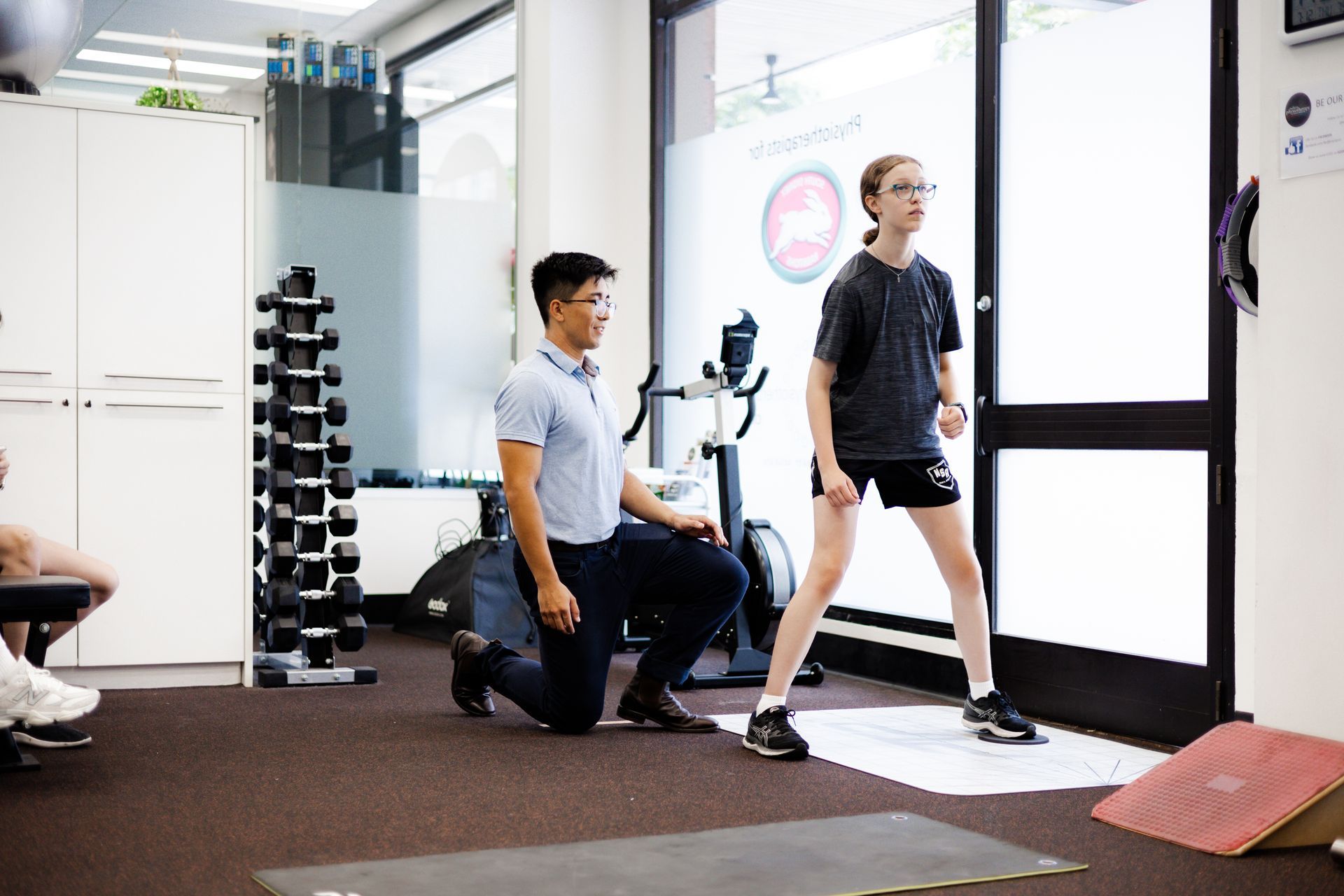Expert Dietitian Services in Redfern
At Redfern Physiotherapy & Sports Medicine, we offer evidence-based dietitian services to support a wide range of health goals — from improving gut health and managing chronic conditions to optimising sports performance and achieving sustainable weight loss.
What We Help With
Expert Dietitian Services in Redfern
At Redfern Physiotherapy & Sports Medicine, we offer evidence-based dietitian services to support a wide range of health goals, from improving gut health and managing chronic conditions to optimising sports performance and achieving sustainable weight loss.
Seeing a dietitian at
Redfern Physiotherapy & Sports Medicine can help you make sense of the often confusing and conflicting information around food and nutrition. Our
Accredited Practising Dietitian, Ellie Thompson, offers clear, evidence based advice that is tailored to your individual health needs, lifestyle, and goals. Whether you’re managing a medical condition, looking to improve your energy and wellbeing, or simply seeking confidence in your food choices, Ellie provides practical, personalised support to help you make informed and sustainable changes.
Seeing a dietitian at Redfern Physiotherapy & Sports Medicine can help you make sense of the often confusing and conflicting information around food and nutrition. Our Accredited Practising Dietitian, Ellie Thompson, offers clear, evidence based advice that is tailored to your individual health needs, lifestyle, and goals.
Whether you’re managing a medical condition, looking to improve your energy and wellbeing, or simply seeking confidence in your food choices, Ellie provides practical, personalised support to help you make informed and sustainable changes.

What We Help With
We support clients across a broad range of health areas, including:
GUT HEALTH
We support clients with IBS, IBD, Coeliac Disease and other gut conditions through personalised nutrition strategies, such as the low FODMAP and low food chemical diets. Our goal is to find the least restrictive diet to reduce your symptoms so you can feel more at ease each day.
FOOD INTOLERANCES & ALLERGIES
We help identify and manage food intolerances or allergies using evidence based approaches like symptom tracking and tailored elimination diets. Our aim is to reduce discomfort while supporting your nutritional needs.
CHRONIC DISEASE MANAGEMENT
Our dietitian provides evidence-based advice to help manage chronic conditions including diabetes, high blood pressure and cholesterol through practical dietary changes that improve health outcomes and quality of life.
SPORTS NUTRITION
From endurance sports to strength based training, we provide personalised sports nutrition and supplementation advice to help you fuel effectively, recover well and reach your performance goals.
WEIGHT MANAGEMENT
We offer realistic and supportive strategies to help with weight loss and body composition goals. No restrictive diets, just sustainable changes that work with your lifestyle.
HEART HEALTH
We support clients with high cholesterol, triglycerides and blood pressure by focusing on evidence-based nutrition strategies and achievable changes to reduce cardiovascular risk.
PLANT-BASED EATING
Whether you are vegetarian, vegan or transitioning to a more plant based lifestyle, we ensure your diet is balanced and nutritionally complete while fitting with your goals and values.
AUTOIMMUNE & INFLAMMATORY CONDITIONS
We provide nutrition support for autoimmune and inflammatory conditions including Rheumatoid Arthritis, Osteoarthritis, Gout and Fibromyalgia to help manage flare ups and support joint and immune health with anti inflammatory dietary strategies.
HEALTHY EATING & DISEASE PREVENTION
We help you build lasting healthy habits that support energy, mood, and overall wellbeing while reducing the risk of chronic disease through balanced, evidence based nutrition.
MINDFUL EATING & LIFESTYLE COACHING
Our approach combines mindful eating and lifestyle coaching to help you develop a healthier relationship with food and make realistic changes that last.
HEART HEALTH
We offer tailored meal planning that takes into account your health conditions, preferences and routine, making it easier to stay on track without added stress.
Why see a Dietitian?
Navigating the vast and often conflicting world of nutrition information can be overwhelming. At Redfern Physiotherapy & Sports Medicine, our Accredited Practising Dietitian, Ellie Thompson, offers clear, evidence-based guidance tailored to your individual health needs and lifestyle. Whether you're managing conditions like IBS, high cholesterol, or diabetes, aiming to enhance athletic performance, or simply seeking to improve your daily eating habits, Ellie provides practical strategies that are both achievable and sustainable.
Ellie adopts a client-centred approach, focusing on long-term, realistic changes rather than restrictive diets or quick fixes. Her areas of special interest include gut health, food intolerances, auto-immune conditions, chronic disease management, and sports nutrition. Collaborating closely with our physiotherapy team, she ensures a holistic approach to your care. No referral is needed to book an appointment, and we welcome all clients, whether you're addressing specific health concerns or seeking general nutritional guidance.
Group Talks & Workshops
In addition to one-on-one consultations, we offer nutrition talks and workshops for local sporting teams, workplaces, schools, and community groups. These sessions are designed to educate and empower participants with practical, evidence-based strategies around food, health, and performance.
If you’re looking to promote health and nutrition within your organisation or community, we’d love to collaborate.
Get in touch to discuss your group’s needs and how we can support your goals.
Book a Dietitian in Redfern
Whether you're looking for support with a specific health condition or simply want to improve your everyday eating habits, our dietitian services at Redfern Physiotherapy & Sports Medicine can help. Ellie offers personalised, practical advice based on your unique needs and goals.
Appointments are available in person at our Redfern clinic or via telehealth. No referral is required. Contact us today to learn more or to book your first consultation.
Why see a Dietitian?
Navigating the vast and often conflicting world of nutrition information can be overwhelming.
At Redfern Physiotherapy & Sports Medicine, our Accredited Practising Dietitian, Ellie Thompson, offers clear, evidence-based guidance tailored to your individual health needs and lifestyle. Whether you're managing conditions like IBS, high cholesterol, or diabetes, aiming to enhance athletic performance, or simply seeking to improve your daily eating habits, Ellie provides practical strategies that are both achievable and sustainable.
Ellie adopts a client-centred approach, focusing on long-term, realistic changes rather than restrictive diets or quick fixes. Her areas of special interest include gut health, food intolerances, autoimmune conditions, chronic disease management, and sports nutrition. Collaborating closely with our physiotherapy team, she ensures a holistic approach to your care.
No referral is needed to book an appointment, and we welcome all clients, whether you're addressing specific health concerns or seeking general nutritional guidance.
Group Talks & Workshops
In addition to one-on-one consultations, we offer nutrition talks and workshops for local sporting teams, workplaces, schools, and community groups. These sessions are designed to educate and empower participants with practical, evidence-based strategies around food, health, and performance.
If you’re looking to promote health and nutrition within your organisation or community, we’d love to collaborate. Get in touch to discuss your group’s needs and how we can support your goals.
Book a Dietitian in Redfern
Whether you're looking for support with a specific health condition or simply want to improve your everyday eating habits, our dietitian services at Redfern Physiotherapy & Sports Medicine can help. Ellie offers personalised, practical advice based on your unique needs and goals.
Appointments are available in person at our Redfern clinic or via telehealth. No referral is required. Contact us today to learn more or to book your first consultation.
Whether you're looking for support with a specific health condition or simply want to improve your everyday eating habits, our dietitian services at Redfern Physiotherapy & Sports Medicine can help. Ellie offers personalised, practical advice based on your unique needs and goals.
Appointments are available in person at our Redfern clinic or via telehealth. No referral is required. Contact us today to learn more or to book your first consultation.
Our latest health blogs



Conveniently located for your care.
Located just a short walk from Redfern Train Station and near Redfern Oval, our clinic is easily accessible by public transport, with free 2-hour street parking available in surrounding streets.
Give us a call at 02 8068 5158 or email info@redfernphysio.com.au











